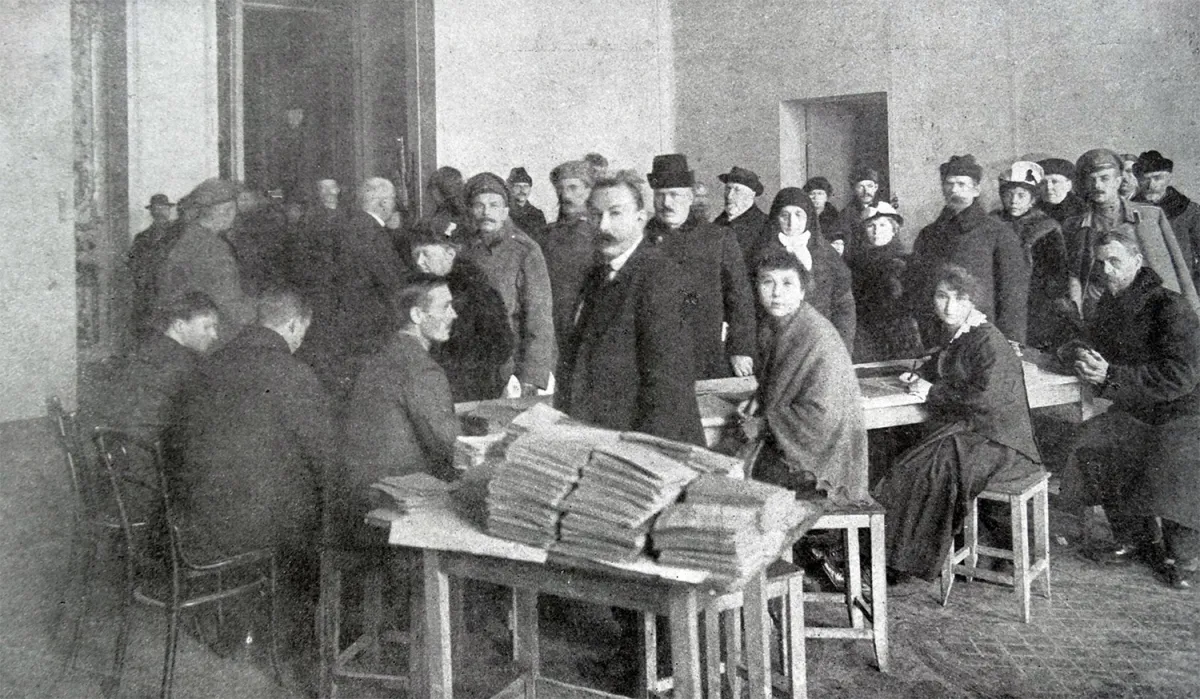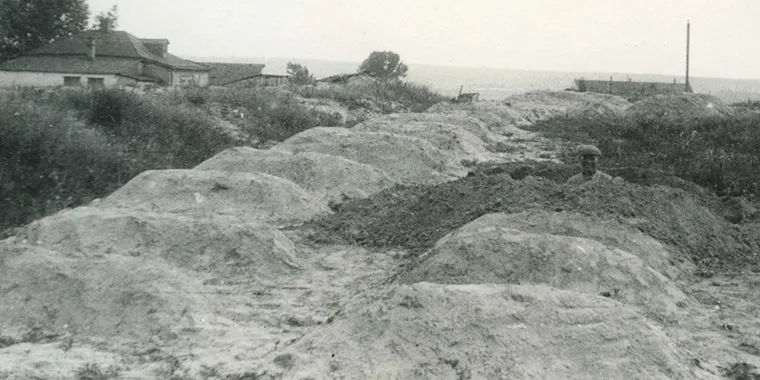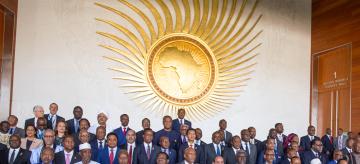What Are the Origins of Communism?
Explore the different ways Marx, Lenin, and Stalin interpreted communism and dive into the history of translating an ideology into policy.
Among the viral TikTok videos of dancing grandparents and decadent dessert recipes, another popular topic has recently racked up more than half a billion views: #communism.
Scroll through the endless short videos associated with the hashtag and you’ll find biographical clips on communist revolutionaries, deepfakes of Joseph Stalin lip-synching to pop hits, and even hammer-and-sickle-themed makeup tutorials.
This isn’t just a fleeting online trend either. Americans are increasingly casting communism as a preferred alternative to a capitalist society. Capitalism is seen by younger generations as responsible for perpetuating economic inequality, racial hierarchy, and the global climate crisis. Recent polls show that nearly 30 percent of Generation Z (ages sixteen to twenty-three) hold a favorable opinion of communism. Meanwhile, support for capitalism continues to plummet among Millennials.
Those opinions, however, split dramatically along generational lines. Just 6 percent of Baby Boomers (ages fifty-six to seventy-four) and only 3 percent of their predecessors, the Silent Generation (ages seventy-five to ninety-three), view communism favorably. This likely tracks back to many older Americans’ experiences of the Cold War. During this period, the former Soviet Union posed an existential threat to U.S. security and prosperity. Others who lived directly under communist regimes in countries like Cambodia, Cuba, and the Soviet Union recall painful experiences of poverty, loss, hunger, and political repression. To them, communism was a failed experiment, not a forward-looking solution.
So what is the best way to make sense of this divide?
One strategy is to look at the difference between the ideology of communism and its implementation. Young people often focus on the ideas behind communism—a political and economic system, first envisioned by Karl Marx, which calls for the elimination of private property and a profit-based economy. In theory, such a system would deliver equality and freedom from poverty. On the other hand, older generations tend to look at the history of how communism has been implemented, causing—in the most extreme examples—the deaths of millions of people.
In this resource, we’ll take a look at both communism in theory and communism in practice. We’ll go back in time to understand how Karl Marx championed the ideology in response to abysmal working conditions in Western Europe. And we’ll explore how two individuals—Vladimir Lenin and Joseph Stalin—translated Marx’s ideology into actionable policy, often with disastrous results.
How did Karl Marx understand communism?
Despite popular misconception, communism did not originate in Russia. Rather, it first took shape in capitals across Western Europe.
In the mid-1800s, Western Europe was experiencing turbulent economic and social changes brought about by a period of groundbreaking innovation called the Industrial Revolution. In cities like Brussels, London, Paris, and Vienna, the rise of factory manufacturing produced a surge in new jobs as well as unprecedented economic growth.
But not everyone benefited equally.
During the Industrial Revolution, a small subset of the population became extraordinarily wealthy. However, the majority of Europeans received low wages and worked long hours in unsafe conditions. Outside of the factory, most people lived in overcrowded and unsanitary neighborhoods. In 1849, residents in one such community published an appeal in a London newspaper:
Sur, – May we beg and beseach your proteckshion and power, We are Sur, as it may be, livin in a Willderniss, so far as the rest of London knows anything of us, or as the rich and great people care about. We live in muck and filthe.
Among the most vocal critics of these conditions was the German philosopher Karl Marx.
Marx was a forceful advocate for the average worker. He and his longtime collaborator, fellow philosopher Friedrich Engels, moved from city to city across Western Europe writing about society’s need to radically rethink its political and economic systems. In his most famous texts, Das Kapital and The Communist Manifesto, Marx introduced two signature theories. First, he argued that workers were suffering because they depended on the upper classes. This upper class owned the factories, raw materials, and machinery needed to produce goods—a system he called capitalism. Second, he believed that revolution was the only way to liberate workers from this system, and that after years of oppression, a workers’ uprising was unavoidable.
But how would revolution happen? According to Marx, the same factory system that subjugated lower-class workers would allow them to overthrow it. Every day, masses of people met on factory floors across Europe to produce goods. Why couldn’t they be organized and deployed into the streets to revolt? “Workers of the world, unite!” Marx wrote. “You have nothing to lose but your chains.”
At the next stage of revolution, the newly empowered proletariat, or working class, would extend voting rights to the entire population and abolish private property. This would lead to the downfall of the upper classes that had thrived under capitalism. Then, a central governing authority would step in to set up a new, planned economy based on matching society’s needs rather than boosting profits.
To Marx, the transition toward this future was more than just likely—it was inevitable. In his writings, he described a future in which the world would eventually have no need for economic classes, money, or even nations.
Recognizing the incendiary nature of these ideas, authorities in Brussels, Cologne, and Paris expelled the German philosopher from their cities. Meanwhile, in Russia, imperial censors permitted the publication of Das Kapital. Russian officials considered the book to be too dense to cause much of a stir. To their surprise, copies of the book flew off the shelves. Marx's Capital would later inspire the world’s first communist revolution.
How did Vladimir Lenin implement communism?
In the early twentieth century, many Russians were furious with their government. Peasant farmers paid high taxes, and factory workers endured poor working conditions. The country also experienced two unpopular wars, the Russo-Japanese War (1904–05) and World War I (1914–18).
For years, people had been trying and failing to overthrow the ruling Romanov dynasty, which had presided over Russia for three centuries. Amid this turmoil, a group of working-class women took to the streets of Petrograd (now St. Petersburg) in February 1917 to protest food shortages and high bread prices. Over the next few days, hundreds of thousands of people joined the protests. Eventually, military leaders defected to their side. By March, Russia’s head monarch, Czar Nicholas II, had abdicated the throne.
The czar’s departure created a power vacuum. Many protesters demanded democracy, but authoritarian forces prevailed instead. In October, the Bolsheviks—a political party led by Vladimir Lenin—seized control in a coup.
Lenin was a revolutionary long before 1917. After being expelled from college for participating in student protests, he spent years studying the works of intellectuals like Marx. And, much like Marx, Lenin moved from city to city across Europe, calling for a workers’ revolution in radical publications.
Upon seizing power, Lenin wasted no time promoting his vision for a Marxist Russia. But what did that mean? In his writings, Marx had mostly refrained from recommending specific policies leaders should enact to create a communist society. Lenin was the first person to attempt to translate Marx’s writings into actual policy. However, the government that resulted from these attempts would ultimately prove neither popular nor fully Marxist. Lenin failed to embrace Marx’s vision for an equitable, democratic society. Instead, Lenin’s government suppressed dissent through strict censoring of the printing presses, theaters, and movie houses. And even when Russians got the chance to vote for a legislative body, Lenin’s Bolshevik party chose to ignore the results. They had received less than 25 percent of the vote.
Additionally, Lenin’s Marxist-inspired efforts to abolish ownership of private land and turn every farm into government property produced disappointing results. Food shortages persisted, the economy faltered, and Russians protested. In response, Lenin enacted the New Economic Policy (NEP) in 1921, which made private property legal again. According to Lenin, this represented a “severe defeat and retreat” from Marxist policy. He soon drifted even further from Marxism by opening up trade with capitalist countries like England.
In 1924, Lenin suddenly passed away. Once again Russia—which had recently become a federation of states called the Soviet Union—faced a crisis over how to implement Marx’s vision.
How did Joseph Stalin implement communism?
After Lenin’s death, various Soviet leaders competed to succeed him; however, one prominent revolutionary stood out as the presumed frontrunner: Leon Trotsky. Trotsky, however, had his rivals—including Joseph Stalin.
On paper, Trotsky and Stalin could not have been more different. Trotsky was a prolific writer and renowned orator. Meanwhile Stalin earned his reputation not through his intellectual contributions to the revolution but through his ability to raise funds for the Bolsheviks. Stalin's most notable fundraising tactics included through robberies, kidnappings, and even piracy on the Black Sea.
When it came time to pick Lenin’s successor, the two waged ideological war. Trotsky called for the Soviet Union to support workers’ revolutions in other countries. This Marxist view adopted by Trotsky was intended to set the world on a path to global communism. In contrast, Stalin called for prioritizing communism at home by focusing on domestic issues.
Over time, Stalin won his war against Trotsky. However, Stalin's victory was not solely on ideological merits. Instead, Stalin assumed power over the Soviet Union by leveraging powerful political alliances. As Stalin gained power, he sent his rival into lifelong exile. Stalin dedicated three floors of his intelligence agency to tracking down Trotsky, who was assassinated in Mexico City in 1940.
Under Stalin’s rule, life in the Soviet Union was a far cry from Marx’s vision of worker empowerment. Although Stalin used the language of Marx and Lenin in his speeches, his policies prioritized ensuring the Soviet Union could compete in the global economy above all else.
In 1928, Stalin scrapped Lenin’s NEP and launched a new program intended to increase the country’s industrial production by 250 percent in just five years. However, under this new program, factory workers struggled to meet unrealistic production goals and faced imprisonment in the Gulag (a government-run forced labor camp) for slacking or absenteeism. Meanwhile, failed agricultural policies resulted in famines that led to the deaths of around six million people.
Additionally, although Marx called for democracy, Stalin did not tolerate even the suspicion of dissent. Between 1936 and 1938, Stalin executed around one million people. This figure includes over one-third of the Communist Party and nearly 80 percent of his highest-ranking military leaders.
Stalin died in 1953, but his legacy shaped the Soviet Union for decades. His policies traumatized and killed millions. Stalin also propelled the Soviet Union into conflict with the United States.
The Cold War, as it was called, never saw the United States and the Soviet Union launch into head-to-head combat. Nevertheless, it roped several countries into proxy wars and brought the world to the brink of nuclear destruction. This existential conflict only ended in the late 1980s and early 1990s when the Soviet Union collapsed after years of economic stagnation and failed political reforms. The world’s first large-scale experiment with communism was over, and it had failed.
How have other countries interpreted and implemented communism?
When thinking about communism, people tend to focus on Soviet leaders like Lenin and Stalin. They were, indeed, the first ones to meaningfully implement the ideology. But around the world, political leaders in various countries have adopted their own interpretations of communism.
Communism Today
Click the arrows or swipe to take the tour.
In China, Communist Party leader Mao Zedong adapted Marx’s and Lenin’s ideologies to call for a peasant revolution in the countryside rather than one led by workers in the cities. That revolution led to decades of conflict and the deaths of millions. However, China’s interpretation and implementation of communism has since evolved into an economic model that blends elements of private entrepreneurship with government control and influence over industries, and today China is a leading force in the global economy—albeit one with a record of serious environmental damage and human rights violations.
Other countries have seen equally diverse interpretations of communism. Cuba’s former communist leader Fidel Castro—a follower of Lenin’s ideology—implemented policies that seized all foreign-owned property in the country, banned private businesses, and limited free speech and political activity at the same time it instituted programs offering free health care and education. Although much of this remains the case, Castro’s successors have introduced limited reforms in an effort to buoy the country’s economy, which has under-performed despite considerable support from China, Russia, and Venezuela.
China, Cuba, and the Soviet Union all identify (or identified) as communist countries. But their dramatically different experiences reveal the gap between an ideology in theory and one in practice. As history demonstrates, ideologies can offer a vision for a more equitable future—but implementation can cause serious harm along the way.





